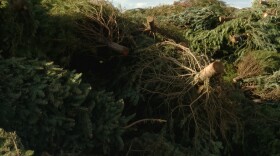October is the start of the toughest season for fighting fires. It’s right after summer, when the vegetation has dried out. It’s the time of the year the Santa Anas will be at their peak, blowing their hot, gusty winds from the inland to the ocean, drying out vegetation that’s already at the ready-to-burn stage.
And add to that three years of historic drought, plus climate change for good measure, and it takes a tough job to a whole new level.
Cal Fire Capt. Thomas Shoots said this is the time of year when fires go from a spark to a “mega” fire of 100,000 acres or more in just a matter of hours. He described the agency’s response “when these fires are getting so explosive, so quickly. We’re ordering everything we can right off the bat, and throwing the world at these fires to try to keep them small.”
He said keeping fires small is not just critical to saving lives and property. The size of a fire determines how quickly a community recovers after the flames are put out.
“They’re burning so hot that they’re really destroying the environment,” he said. “A lot of times they’re essentially moonscaping these areas and taking all the nutrients out of the soil, and they’re not good for the long term of the survivability of these areas.”
In order to keep fires under control, firefighters must know where their resources are at all times and stage them accordingly. Technology got rid of the old paper fire maps. Shoots pulls out an iPad that strategically shows trails, and blue and black squares where resources are located across the county, including which ones are out of service and which ones belong to what departments.
And while Shoots said they have plenty of resources, he added that, historically when there is critical fire weather, multiple fires break out in many areas of the state — and those resources are stretched thin.
“Our neighbors to the north, which usually send resources down to us, aren’t going to be able to do so. And that’s when it becomes really critical for folks to get out of harm's way as quickly as possible and to help us prepare for events like that,” he said.
Year-round, Cal Fire works with homeowners to mitigate fire danger. And that is not easy. They have to maintain about half of the county, or about 1.5 million acres, and a large portion of the East County is rural backcountry, prone to fire danger.
Shoots said the unincorporated community of Crest near El Cajon is an example of successful clearing in an area where fires had big potential for spreading.
“Our focus became to create this buffer going along the edge of this community, to really try and stop any kind of fire working its way in,” he said as he pointed to the ridgetop dotted with homes.
Shoots said they are also careful not to do too much. “We do what is called an 80/20 cut. So we’re cutting 80% of the vegetation but leaving 20 to help stabilize the soil [to] try and prevent any kind of erosion.”
But for those who want to clear their property, Shoots warns that now is not the time to use mechanized equipment late in the day, because one spark will start a fire.
Shoots also stressed cooperation during an emergency. He said under normal conditions, evacuations can be daunting in some areas where roads are poorly lit or there is just one way in and out; routes that evacuees would have to share with fire equipment.
“Julian, Palomar a lot of the mountain top communities [have] one way sometimes two ways in and out and [it’s] a real challenge to get people out of these areas,” he said.
And right now, with moisture levels at critical lows, it’s vital to heed warnings early.
“We’ve seen from the studies that it would take eleven hours to evacuate 80 percent of Ramona. Eleven hours is something that we’re not going to have when the fire is blowing through there,” he said.
Shoots also said some people should leave when there is an evacuation warning, and not wait until there is an order. Those include people with mobility issues, people with livestock or those who need extra time or who live in areas with challenging terrain.
Shoots said it’s important for people to take the time to get their families and homes ready.
“The brush and the grass are ready to burn. That's why this time of year is so critical and why it’s so important for folks throughout San Diego County but especially our folks living out in the backcountry that they’re prepared and ready to evacuate at a moment’s notice.”
Information about fire preparedness and emergency planning can be found online at https://www.readyforwildfire.org/.







